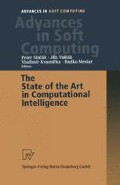Abstract
We propose a novel neural network model for representing data structures. The model consists of a hierarchy of Self-Organizing Maps (SOMs) equipped with leaky integrating units. Each of the maps is thus designed to represent sequences of data in a fashion resembling Barnsley’s iterated function system. Each data structure is decomposed into a hierarchy of sequences where in all but the lowest levels a special symbol is substituted to represent corresponding subtrees. The advantage of this representation is that it is directly computable, and if neurally implemented using SOMs, it is computationally unexpensive. Preliminary simulations using simple symbolic tree structures demonstrate that obtained representations have the required property of systematic order.
Access this chapter
Tax calculation will be finalised at checkout
Purchases are for personal use only
Preview
Unable to display preview. Download preview PDF.
References
J.A. Fodor and Z.W. Pylyshyn. Connectionism and cognitive architecture: A critical analysis. Cognition, 28: 3–71, 1988.
J.B. Pollack. Recursive distributed representations. Artificial Intelligence, 46 (12): 77–105, 1990.
P. Smolensky. Tensor product variable binding and the representation of symbolic structures in connectionist systems. Artif. Intelligence, 46: 159–216, 1990.
T. Plate. Holographic reduced representations. IEEE Transactions on Neural Networks6(3):623–641, 1995
L. Shastri and V. Ajjanagadde. From simple associations to systematic reasoning. Behavioral nad Brain Sciences, 16 (3): 417–494, 1993.
J.E. Hummel and K.J. Holyoak. Distributed representations of structure: a theory of analogical access and mapping. Psych. Review, 104 (3): 427–466, 1997.
D.J. James and R. Miikkulainen. Sardnet: a self-organizing feature map for sequences. In Advances in Neural Information Processing Systems 7, 1995.
K. Kopecz. Unsupervised learning of sequences on maps with lateral connectivity. In ICANN’95, pages 431–436, Paris, France, 1995.
J. Göppert and W. Rosenstiel. Dynamic extensions of self-organizing maps. InProceedings of ICANN’94pages 330–333, 1994
G.J. Chappell and J.G. Taylor. The temporal Kohonen map.Neural Networks6:441–445, 1993
T. Koskela et al. Time series prediction using recurrent SOM with local linear models. Int. Journal of Knowledge-Based Intell. Eng. Systems, 2: 60–68, 1998.
M. Barnsley. Fractals Everywhere. Academic Press, 1988
I. Farkas. Invariance of gaussian-vector mapping using a self-organizing map.Neural Network World7(2):153–159, 1997
L. Niklasson and M. Bodén. Representing structure and structured representations in connectionist networks. In A. Browne, editor, Neural Network Perspectives on Cognition and Adaptive Robotics, pages 20–50. IOP Press, 1997.
P. Tino. Spatial representation of symbolic sequences through iterated function systems. IEEE Trans. on Systems, Man and Cybernetics, 29 (4): 386–392, 1999.
T. Kohonen. Self-organizing maps of symbol strings. Technical report A42Helsinki University of Technology, Espoo, Finland, 1996
N.E. Sharkey Connectionist representation techniques.Artificial Intelligence Review5:143–167, 1990
Author information
Authors and Affiliations
Editor information
Editors and Affiliations
Rights and permissions
Copyright information
© 2000 Springer-Verlag Berlin Heidelberg
About this paper
Cite this paper
Farkaš, I. (2000). Self-Organizing Maps for Representing Structures. In: Sinčák, P., Vaščák, J., Kvasnička, V., Mesiar, R. (eds) The State of the Art in Computational Intelligence. Advances in Soft Computing, vol 5. Physica, Heidelberg. https://doi.org/10.1007/978-3-7908-1844-4_5
Download citation
DOI: https://doi.org/10.1007/978-3-7908-1844-4_5
Publisher Name: Physica, Heidelberg
Print ISBN: 978-3-7908-1322-7
Online ISBN: 978-3-7908-1844-4
eBook Packages: Springer Book Archive

